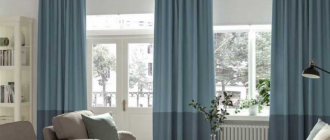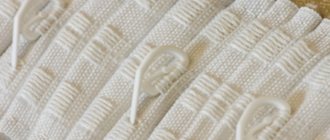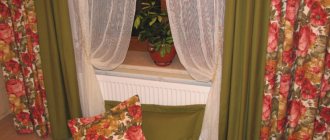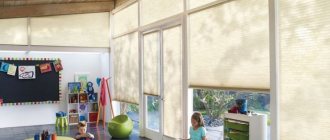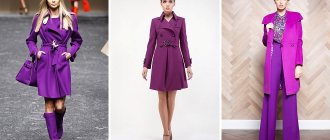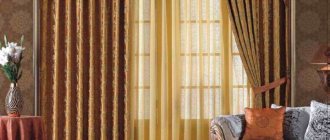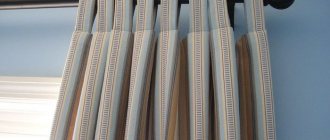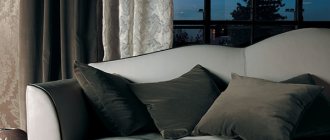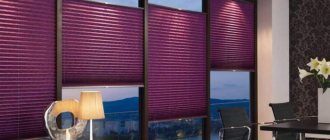Two-color curtains are a modern trend that allows you to decorate a window in an extraordinary way and complement the color scheme of the interior. What are these curtains, what interior styles are they used in, how not to make a mistake when choosing two colors - you will discover these and other secrets by reading our article or just looking at the photo.
First, let's clarify what is meant by two-color curtains:
- standard set of two curtains of different colors for one window;
- a set of 4 or more curtains in different shades of the same or contrasting colors;
- double-layer (double-sided) curtains;
- gradient curtains (ombre) with color transition;
- several curtains, differing in the degree of transparency.
Curtains of two colors on one window have not gone out of fashion for several seasons, decorating modern and classic interiors, presenting many combinations of colors, fabrics and textures.
Original and beautiful, they are capable of modeling space - expanding or narrowing walls, bringing windows closer or further away. But most importantly, such curtains create an atmosphere of comfort or celebration and will transform every room of the house.
Features of combining curtains of two colors
Following the basic principles of combining two curtains of different colors will help you correctly adjust the geometry of the room:
- The classic way is a harmonious combination of two colors in accordance with the overall color palette of the room.
- A combination of different shades of the same color helps to create a unified space. This can be a set of different shades of green, cornflower blue, olive or red.
- The combination of contrasting colors serves as an option to highlight color accents in the design of the room. This method of decorating window openings is often used by creative individuals. In this case, one of the colors of the curtains is selected to match the color spots in the interior.
Ready-made options for the ideal combination and combination of curtains in two colors can be viewed here.
Experts advise selecting color combinations using a table of color combinations and their shades. As a result, you can get unexpected and very successful solutions from a decorative point of view.
How to hang beautifully: ideas for double and double-sided curtains
The appearance of curtains depends not only on the fabric and cut, but also on the way they are attached to the curtain rod. Moreover, an unsuccessful fastening method can negate all other advantages, while a successful one, on the contrary, can hide the shortcomings of the fabric and cut.
For combined and double-layer curtains, designers offer a huge number of mounting options. Each of them is good in its own way, and we just have to choose the one we like best or come up with our own original way. Here are just a few of them:
- hang canvases of different colors in a row on a single-profile or tubular cornice or one after another on a cornice with two tracks;
- assemble curtains (one, two or all four) with tiebacks or holders or magnets;
- collect the fabric located at the top in the center onto a curtain clip or thread it into a pre-prepared loop, forming a kind of airy “sleeve”.
- hang combined curtains crosswise: both curtains are hung across the entire width of the window on a double cornice, drawn in different directions and secured with tiebacks.
A universal solution for attaching double curtain sets can be considered round metal curtain rods with two pipes, capable of supporting heavy fabrics and, thanks to the variety of textures (wood, gold, chrome, colored plastic) and tips, fitting into all interior styles.
Double-row metal cornice is best suited for fastening double textile panels
Three simplest ways to beautifully hang two curtains of different colors
In order to beautifully drape double and double-sided curtains, there are many ways: tiebacks, pins, holders
Curtain styles in two colors
Curtains combined from two colors are easy to fit into any interior, showing a competent and non-standard approach.
Colors
When choosing colors for curtains, you can combine:
- contrasting colors characteristic of modern trends;
- shades of the same color scheme, often inherent in interiors in a classic style.
In other words, you either select curtains to match the dominant colors in the setting, or bring into the room elements of rich colors present on the curtains.
If window textiles do not duplicate the colors found in the interior, you may have the question “What to combine bright curtains with?” In cases where you are not ready to give expressive colors to large objects like a sofa or carpet, limit yourself to placing small accents.
Most often, the additions are sofa cushions made from the same fabrics as the curtains. But these can also be small objects - vases, candy bowls, figurines, fringe on a tablecloth.
In addition to personal taste and preferences, the choice of curtain colors is also influenced by the style of the room. For example, plain canvases of two different colors would be appropriate in a minimalist style.
Laconic long curtains with light drapery are universal. Plain curtains will balance classic interiors, where the main accent is exquisite furnishings.
The combination of several monochrome curtains will look organic in many other directions: loft, pop art, modern, art deco, English, Roman, Chinese styles. Striped or checkered curtains, which combine perfectly with plain fabrics, are equally widely used.
Floral prints are characteristic of classics, Provence, country and their modern incarnations. Abstract, futuristic images or pictures are characteristic of ultra-modern interiors, and monograms are usually associated with baroque, classic and rococo.
Curtains of two colors will help adjust the proportions of the room. However, to raise or expand the walls, you can use a ceiling or wide cornice.
Curtains with a large pattern will visually bring the window closer, while those with a small pattern will move it away. A light drawstring or horizontal stripe at the top of the curtain on the eyelets will widen the window opening, while a dark one will narrow it. Bright and warm colors eat up space, cold colors do the opposite.
It is believed that curtains that contrast with the walls and general decor will be appropriate in the living room and kitchen. And calm, peaceful tones a little lighter or darker than the walls are more suitable for a bedroom or nursery.
This doesn't mean you can't do the opposite. Interior design, like fashion in general, is very controversial, as evidenced by these photos. All that remains is to decide whether the curtains will be an accent or an addition.
Kitchen
Curtain sets for the kitchen should be easy to clean and convenient for daily use. They are designed to fill the room, where the whole family often gathers, with positivity and homeliness at the same time. The combination is selected depending on the overall palette and area of the room. The curtain for the kitchen in two colors can be either short or to the floor. It depends on the area of the room and the tastes of the owners.
Versatility
Tulle is suitable for rooms of various functional purposes. It will look good both in the kitchen and in the living room, bedroom or children's room. This lightweight material does not block light, creates a feeling of visual spaciousness and does not require complex care. Curtains of almost any style can be made from tulle fabric, from classic straight ones to Roman blinds or Japanese panels.
Tulle combines very well with curtains made from other fabrics. A curtain made of this material will highlight velvet curtains and drapes made of brocade or other textured fabric. It will help make roller blinds less formal and soften their laconic severity.
The color schemes of this material are no less varied than its other characteristics. Light shades are more common, but dark color options are also available. But even fabric of dark colors looks light and mysterious.
Tulle is not always monochromatic. There are options with metal threads, embroidery, floral and abstract patterns. Among such variety, you can always choose the option that is perfect for a particular room.
Bedroom
Curtain combinations of calm tones made from natural fabrics are appropriate for a relaxation room. To create a comfortable and relaxed atmosphere, it is easy to sew two-layer curtains that will protect the room from excess light and street noise. Curtains for a bedroom in two colors suggest, first of all, a combination of two shades of the same color, since a play of bright contrasts is not appropriate in a relaxation room.
Choosing a color scheme
Curtains made of fabrics of two colors must comply with the following general decorating principles:
- Companions should combine the two dominant colors in the surrounding space. Ornament and design are appropriate in rooms where there are no too bright decorative elements.
- To visually expand the room, fabrics with horizontal patterns can be used. Plain curtains are suitable for rooms loaded with decorative elements; for minimalism, you should choose something brighter.
- The living room will become more sunny and lively if double curtains of green and yellow are hung on the windows. For monochrome options, it is worth choosing combinations of white and black, brown and turquoise, chocolate and pink.
- The best option for the bedroom would be double-sided curtains made from the same fabric. Depending on the time of year or simply the mood of the owners, they can be hung with one side or the other towards the window.
- Combined curtains look best when, when combined horizontally, the darker shades are at the bottom. This effect can be achieved using fabric with a smooth stretch of color in the “ombre” type.
Combined curtains
If someone wants to sew curtains from two fabrics of different colors with their own hands, you need to consider:
- that combining red and burgundy is quite dangerous; it is best to dilute them separately with calmer and neutral shades;
- the fact that the predominance of white will create an atmosphere of comfort and peace in the house;
- that blue and white will refresh any interior;
- that in order to “warm up” a cold room you can hang thick curtains the color of ripe orange and a green transparent curtain on the windows.
Combined tulle curtains
How to sew two-color curtains
The simplest option for curtains in two colors are straight models, sewn from two different-colored halves.
When calculating material consumption, it is necessary to measure the height of the room and the size of the cornice. The cost of seams should be added to the data obtained.
The canvas is selected both by color and texture.
Operating procedure
- To cut, the fabric must be ironed. Experienced seamstresses advise letting the fabric hang a little first.
- Measure out two identical halves and cut the canvases along a vertical line.
- The resulting halves of different colors are joined with a seam, and the edges of the product are processed.
- The connecting seam of the two halves also requires careful processing.
- All seams must be ironed.
- The bottom edge of the product is carefully folded and stitched on a machine.
- It is recommended to sew curtain tape to the top edge. It is recommended to first secure it with a hand stitch.
If desired, it is easy to sew curtains with a horizontal combination of two colors.
Combined models from leftover matter
With some creativity, it’s easy to make two-tone curtain designs from leftover fabric.
The simplest options would be:
- curtains made of vertical stripes;
- combined curtains in Provence style made of plain and patterned fabric.
It’s easy to combine plain fabrics and checkered or floral fabrics in a curtain set. It’s easy to combine basic fabrics with ruffles and tiebacks of a different color.
Diversity
Tulle curtains can have any purpose. In some cases, they complement heavy and textured curtains, while in others they are the central element of the composition and create its mood.
If there is no significant commitment to any particular style in the interior of the room, then a single-color type of fabric is selected. Usually preference is given to white or pastel shades. Variegated tulle looks no less interesting, but in this case all other components should be made in a restrained color scheme.
It should be remembered that only one textile element should be multi-colored with bright colors. In terms of combinations, it is better to choose shades that differ by several tones or contrast with each other.
If we consider the stylistic component of the design, then in this case there are certain recommendations. For a country-style interior, a cotton tulle complemented by a wooden cornice is suitable. The room will be decorated in a classic manner with curtains made of relatively heavy and textured fabric.
Tulle on eyelets suits a modern-style interior. The canvas forms even folds that look stylish, elegant and discreet. Correctly selected eyelets will become an element of decor in the room.
It should be noted that the classic option is to use tulle in one piece. But often wide is not always convenient. It makes it difficult to open the window for ventilation, and it becomes more difficult to water the flowers. That is why, in some cases, tulle made of two halves is used to decorate a window. When they are moved, it is almost not noticeable that the canvas consists of 2 parts. But approaching the window is much easier. It is enough just to slightly move one of the halves.
Tulle made of two or more parts is also used in cases where the window is too large for the canvas. Panoramic ones cannot be covered with one curtain of standard width. It should be noted that the joints are practically invisible due to the drapery. However, when choosing this option, you should take into account that canvases with a pattern require a matching pattern, i.e., adjustment is needed.
Caring for two-color curtains
Curtains need to be washed regularly. This point must be taken into account at the stage of choosing fabrics.
Curtains made of two colors must first be soaked in warm water.
Modern washing machines have a delicate wash mode, which is quite suitable for curtains.
After washing, it is recommended to dry the product flat on a horizontal surface. This is especially important for sets, when sewing which materials of different textures were used.
Dried curtains should be carefully smoothed out. During the ironing process, much attention is paid to the connecting seams.
The use of two-color curtains in interior decor will allow you to decorate any living space in an original way. It’s easy to come up with design ideas for curtain sets yourself, using a photo of curtains in two colors as a basis.
How to calculate fabric for curtains?
Calculations can only begin after the cornice has been installed. Then you will need to arm yourself with a metal construction tape measure and take the necessary measurements.
What needs to be taken into account when calculating the parameters of curtains made of two panels:
- desired length and width of the finished curtain;
- shrinkage allowance;
- presence of a pattern on the fabric.
Calculation of fabric length
First you need to decide how long the curtains are needed. There are several options:
- 1 cm above the window sill;
- 10-15 cm below the window sill;
- 1-2 cm above the floor;
- lie on the floor in a trail of 5-10 cm.
The length will also be affected by the types of fastening of the curtain to the curtain rod:
- Hooks, clothespins, clips. To hem the fabric at the top you need to leave an additional 2-3 cm.
- Eyelets are rings made of plastic, wood or metal. To calculate the length, you need to add 10-20 cm to the width of the lining tape.
- Loops or ribbon ties can be sewn to the top. Here it is enough to add a couple of centimeters on top to the hem of the fabric.
- For curtain tape, you will need to multiply its width by 2 and add 2-3 cm to the top edge.
- The drawstring requires adding its width to the length of the curtain. Usually it is 3-20 cm.
Thus, the length of the fabric is calculated taking into account the desired length of the finished product, the allowance for fastening to the cornice and for the hem at the bottom.
Calculation of material by width
Here, too, the main point remains the cornice. You need to take into account its length, and also leave 20-25 cm on each side, since these areas should remain open. The resulting value must be multiplied by the fabric assembly factor, which depends on the type of material:
- tulle, organza – 2-4;
- heavy matter – 1.5-2.
The larger the pattern, the fewer folds need to be formed, so the coefficient for fabric with a large print can be taken less.
And the last thing you need to add to the resulting value is the allowance for processing the seams on the sides. Usually there are two curtains on the window, so you need to add a couple of centimeters 4 times plus 2 cm for the seam in the middle of each curtain.
Shrinkage allowance
The more natural the fabric, the more it can shrink when washed. So, linen or cotton can decrease by 10%. To be on the safe side, add 5-8 cm in length. It is advisable to pre-wash the material before sewing. Sometimes for natural shrinkage it is enough to treat it with steam. After this, the fabric is dried and work begins.
Stock for curtains with large prints
It is important to consider the size of the pattern on the canvas. Sometimes you have to retreat a sufficiently large distance so that the patterns remain entirely on the curtain. If you buy too little material, then there will be nowhere to retreat; you will have to sew curtains with halves of the design elements.
It is important to take into account the direction of the pattern. Also, the canvases come in different widths: 1.4 m, 2.8 m, 3 m.
